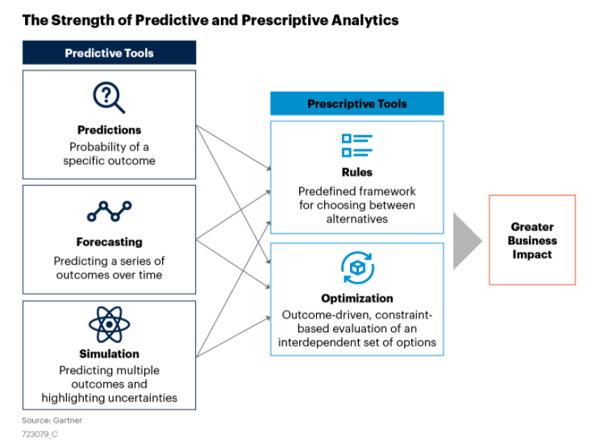The bulk of an organization’s data science, machine learning, and AI conquests come down to improving decision-making capabilities. Teams may aim to achieve new levels of agility, expedite the time to insights, or refine the process leading up to the business value extraction so that it’s more efficient. When during this process, though, should data executives get either predictive or prescriptive? Is there a time when both analytics approaches should be used in unison? We’ll unpack the answers in this blog post.
To begin, let’s break down the key differences between predictive and prescriptive analytics:
Predictive analytics aim to predict what is going to happen and aren’t valuable unless they are actionable. Examples of popular predictive analytics use cases include churn prevention, demand forecasting, fraud detection, and predictive maintenance.With the example of churn prevention, the goal would be to figure out what the customer is ultimately going to do and when so that the organization can intervene and hopefully avoid the churn (or at least mitigate the risks associated with it).
Prescriptive analytics take predictive analytics one step further — not only do they provide new information to make the aforementioned forecasts and predictions a reality, but they represent a paradigm shift and further model development. If predictive analytics cover what is bound to happen, prescriptive analytics aim to deduce the steps that should be taken to achieve a certain outcome — they’re much more actionable than their predictive counterpart. Staying with the churn reduction example, prescriptive analytics involve figuring out how to make the customers stay (such as by building targeted marketing campaigns for those customers like in this uplift modeling example).
Prescriptive solutions should be leveraged when you need to move beyond predictive analytics, such as with a recommendation engine that weighs your business needs against model outcomes. Once tools with forecasting capabilities are in place, the business problem or objective is outlined and prescriptive analytics arm managers with a path to success to improve business outcomes and provide value. Additional examples of prescriptive analytics at work may include:
- Predictive maintenance: going beyond “this machine will likely break on this date” to “this is the best time to take it out of service” to respond proactively
- Supply chain optimization: instead of just forecasting shipping delays and lead times during a busy period, finding a new solution to avoid these delays at all (i.e., new supplier relationships, new delivery routes, etc.)
- Financial services: working to decide which services and products to offer to certain customers based on specific actions they’ve taken (i.e., opening a new account)
Should You Use Both Approaches Together?
Although prescriptive analytics is quite a buzzword phrase in the analytics space, many data and analytics leaders actually have limited experience with their real-world application (or don’t know that, yes, prescriptive analytics can be used together with predictive analytics).
While the process for combining predictive and prescriptive analytics won’t always make sense (and will vary depending on the business problem and its complexity), doing so can be significantly beneficial in working toward finding a solution to said problem. According to Gartner, “Bringing together forecasts (a form of predictive analytics) with optimization (a form of prescriptive analytics) lets an organization explore how changes to different variables are likely to affect the outcomes or alter the relative trade-offs. This combined, composable approach gets to the heart of the task of adding business value.”*
 Source: Gartner
Source: Gartner
At its core, moving from predictive to prescriptive analytics is the natural next step for organizations keen on becoming more proactive and less reactive, working to solve the issues brought up in the predictive data analysis. Predictive analytics sets the stage by producing the raw material for making more sound and informed decisions, while prescriptive analytics produce an array of decision options to weigh against each other and, ultimately, make the one that has the greatest impact on the business.
Particularly as industries continue to cope and regain their footing amidst the global health crisis, finding ways to drive desired outcomes or accelerate results will be critical, and the right balance of predictive and prescriptive analytics can help.
*Gartner, When and How to Combine Predictive and Prescriptive Techniques to Solve Business Problems, 2020





